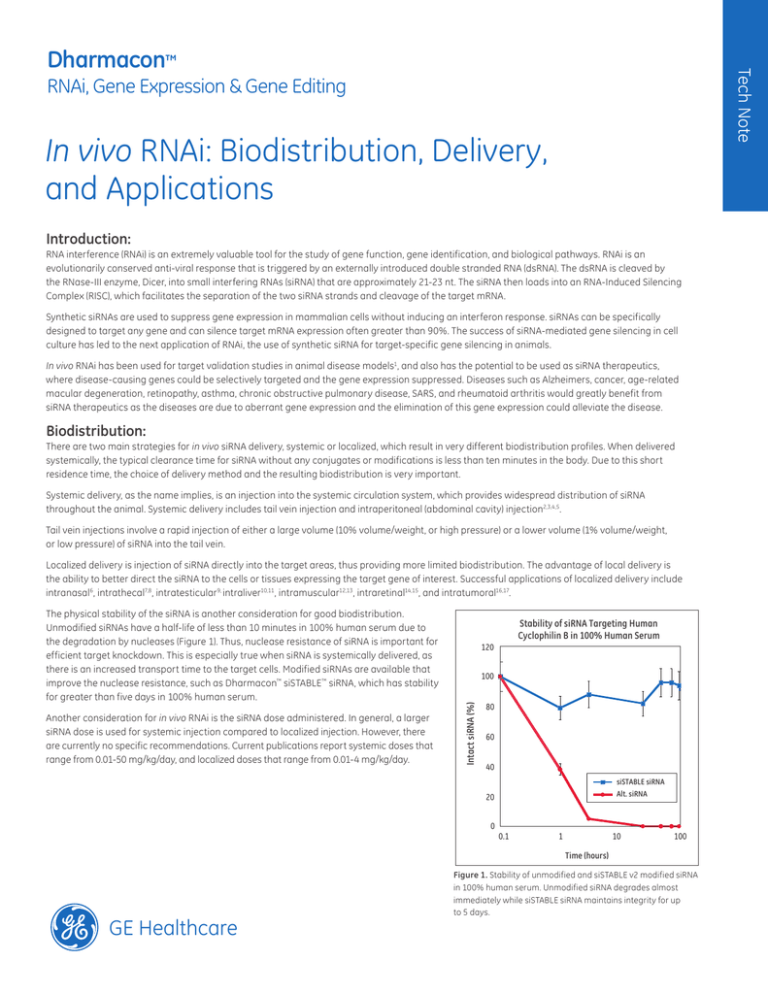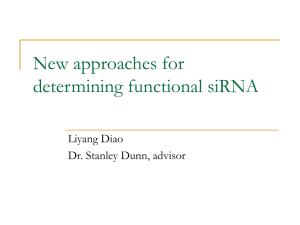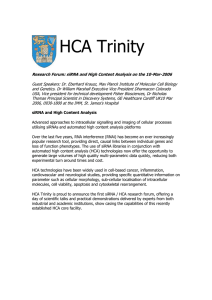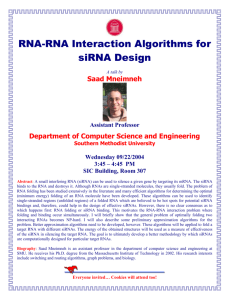
Tech Note
Dharmacon™
RNAi, Gene Expression & Gene Editing
In vivo RNAi: Biodistribution, Delivery,
and Applications
Introduction:
RNA interference (RNAi) is an extremely valuable tool for the study of gene function, gene identification, and biological pathways. RNAi is an
evolutionarily conserved anti-viral response that is triggered by an externally introduced double stranded RNA (dsRNA). The dsRNA is cleaved by
the RNase-III enzyme, Dicer, into small interfering RNAs (siRNA) that are approximately 21-23 nt. The siRNA then loads into an RNA-Induced Silencing
Complex (RISC), which facilitates the separation of the two siRNA strands and cleavage of the target mRNA.
Synthetic siRNAs are used to suppress gene expression in mammalian cells without inducing an interferon response. siRNAs can be specifically
designed to target any gene and can silence target mRNA expression often greater than 90%. The success of siRNA-mediated gene silencing in cell
culture has led to the next application of RNAi, the use of synthetic siRNA for target-specific gene silencing in animals.
In vivo RNAi has been used for target validation studies in animal disease models1, and also has the potential to be used as siRNA therapeutics,
where disease-causing genes could be selectively targeted and the gene expression suppressed. Diseases such as Alzheimers, cancer, age-related
macular degeneration, retinopathy, asthma, chronic obstructive pulmonary disease, SARS, and rheumatoid arthritis would greatly benefit from
siRNA therapeutics as the diseases are due to aberrant gene expression and the elimination of this gene expression could alleviate the disease.
Biodistribution:
There are two main strategies for in vivo siRNA delivery, systemic or localized, which result in very different biodistribution profiles. When delivered
systemically, the typical clearance time for siRNA without any conjugates or modifications is less than ten minutes in the body. Due to this short
residence time, the choice of delivery method and the resulting biodistribution is very important.
Systemic delivery, as the name implies, is an injection into the systemic circulation system, which provides widespread distribution of siRNA
throughout the animal. Systemic delivery includes tail vein injection and intraperitoneal (abdominal cavity) injection2,3,4,5.
Tail vein injections involve a rapid injection of either a large volume (10% volume/weight, or high pressure) or a lower volume (1% volume/weight,
or low pressure) of siRNA into the tail vein.
Localized delivery is injection of siRNA directly into the target areas, thus providing more limited biodistribution. The advantage of local delivery is
the ability to better direct the siRNA to the cells or tissues expressing the target gene of interest. Successful applications of localized delivery include
intranasal6, intrathecal7,8, intratesticular 9, intraliver10,11, intramuscular12,13, intraretinal14,15, and intratumoral16,17.
Another consideration for in vivo RNAi is the siRNA dose administered. In general, a larger
siRNA dose is used for systemic injection compared to localized injection. However, there
are currently no specific recommendations. Current publications report systemic doses that
range from 0.01-50 mg/kg/day, and localized doses that range from 0.01-4 mg/kg/day.
Stability of siRNA Targeting Human
Cyclophilin B in 100% Human Serum
120
100
Intact siRNA (%)
The physical stability of the siRNA is another consideration for good biodistribution.
Unmodified siRNAs have a half-life of less than 10 minutes in 100% human serum due to
the degradation by nucleases (Figure 1). Thus, nuclease resistance of siRNA is important for
efficient target knockdown. This is especially true when siRNA is systemically delivered, as
there is an increased transport time to the target cells. Modified siRNAs are available that
improve the nuclease resistance, such as Dharmacon™ siSTABLE ™ siRNA, which has stability
for greater than five days in 100% human serum.
80
60
40
siSTABLE siRNA
Alt. siRNA
20
0
0.1
1
10
100
Time (hours)
GE Healthcare
Figure 1. Stability of unmodified and siSTABLE v2 modified siRNA
in 100% human serum. Unmodified siRNA degrades almost
immediately while siSTABLE siRNA maintains integrity for up
to 5 days.
Delivery Reagents:
Delivery reagents that facilitate efficient siRNA entry into cells include siRNA conjugates and complexes. Conjugates that have been employed include
cholesterol and peptides, that can be covalently linked to the chemically stabilized siRNA molecule, aiding uptake into tissues3. Several delivery reagents that
complex siRNA to facilitate cellular uptake are cationic liposomes, dendrimers, and atelocollagen 2,9. Cationic liposomes have been relatively successful in cell
culture, although they require lengthy optimization of transfection conditions. Limitations of cationic lipids include the lack of ability to transfect a vast number
of cell types and undesirable levels of toxicity. For in vivo applications, cationic liposomes have been shown to be less effective and more toxic. Compared to
cationic lipids, polymer-based dendrimers display greater transfection efficiency and less toxicity in many cell types, thus may have a greater potential for
in vivo application. Finally, atelocollagen, a naturally occurring protein that is low in immunogenicity, is used clinically for a wide range of purposes. Atelocollagen
has been shown to allow increased cellular uptake, nuclease resistance and prolonged release of genes and oligonucleotides. Atelocollagen displays low-toxicity
and low-immunogenicity when transplanted in vivo.
Additionally, electroporation has been used for localized delivery to skin and muscle as it is effective with nearly all cell and species type and may be performed
with intact tissue12,13,15. However, several disadvantages of electroporation include cell damage, rupture, and cell death.
Detection Methods
The method of knockdown detection will depend on whether the siRNA molecule itself or the activity of the siRNA is being measured. For detection of the
siRNA molecule, a label attached to the molecule, such as fluorescence or radioactivity, can be used to measure uptake. The fluorescent-labeled siRNA
molecule may be easy to synthesize and use, but it is possible that the label will change the siRNA pharmacokinetics. In contrast, radioactivity uptake
provides good biodistribution data, but has regulatory requirements and poses technical and handling challenges. Additionally, non-fluorescent labels
include biotin, digoxigenin, and BRDU (bromodeoxyuridine). These labels may be detected immunologically or enzymatically. Alternatively, a transgenic
mouse expressing EGFP can be used to visualize the effect of EGFP siRNA. For the detection of the siRNA activity, either the phenotype of the knockdown
or target mRNA/protein levels can be analyzed. A phenotypic assay is usually quite simple, but may be easily misinterpreted, as the phenotype may be
caused by multiple factors, and is not a direct assessment of the mRNA knockdown. The detection of mRNA and protein levels is the most reliable method
for determining siRNA functionality and biodistribution. However, the isolation of mRNA and protein in vivo is much more difficult than in cell culture.
References:
1.
2.
3.
4.
5.
6.
7.
8.
9.
10.
11.
12.
13.
14.
15.
16.
17.
F.Y. Xie, P.Y. Lu, et al., Delivering siRNA to Animal Disease Models for Validation of Novel Drug Targets In Vivo. PharmaGenomics 28-38 (2004).
D.R. Sorensen, M. Leirdal, et al., Gene silencing by systemic delivery of synthetic siRNAs in adult mice. J. Mol. Biol. 327(4), 761-766 (2003).
J. Soutschek, A. Akinc, et al., Therapeutic silencing of an endogenous gene by systemic administration of modified siRNAs.
Nature 432(7014), 173-178 (2004).
H. Watanabe, H. Saito, et al., Aging is Associated with Decreased Pancreatic Acinar Cell Regeneration and Phosphatidylinositol
3-kinase/Akt Activation.Gastroenterology 128(5), 1391-1404 (2005).
D. Lewis, J.E. Hagstrom, et al., Efficient delivery of siRNA for inhibition of gene expression in postnatal mice. Nat Genet 32(1), 107-108 (2002).
V. Bitko, A. Musiyenko, et al., Inhibition of respiratory viruses by nasally administered siRNA. Nat. Med. 11(1), 50-55 (2005).
G. Dorn, S. Patel, et al., siRNA relieves chronic neuropathic pain. Nucleic Acids Res. 32(5), e49 (2004).
P.H. Tan, L-C Yang, et al., Gene knock down with intrathecal siRNA of NMDA receptor NR2B subunit reduces formalin-induced nociception in
the rat. Gene Therapy 12, 59-66 (2005).
Y. Minakuchi, F. Takeshita, et al., Atelocollagen-mediated synthetic small interfering RNA delivery for effective gene silencing in vitro and in vivo.
Nucleic Acids Res. 32(13), e109 (2004).
A.P. McCaffrey, H. Nakai, et al., Inhibition of hepatitis B virus in mice by RNA interference. Nat. Biotech. 21, 639-644 (2003).
A.P. McCaffrey, L. Meuse, et al., Gene expression: RNA interference in adult mice. Nature 418(6893), 38-39 (2002).
M. Golzio, L Mazzolini, et al., Inhibition of gene expression in mice muscle by in vivo electrically mediated siRNA delivery.
Gene Therapy 12(3), 246-251 (2004).
X.C. Kong, P. Barzaghi, et al.,, Inhibition of synapse assembly in mammalian muscle in vivo by RNA interference. EMBO Rep. 5(2), 183-188 (2004).
S. Reich, J. Fosnot, et al., Small interfering RNA (siRNA) targeting VEGF effectively inhibits ocular neovascularization in a mouse model.
Mol. Vis. 9, 210-216 (2003).
T. Matsuda, C.L. Cepko, Inaugural Article: Electroporation and RNA interference in the rodent retina in vivo and in vitro. PNAS 101(1), 16-22 (2004).
S. Filleur, A. Courtin, et al.,SiRNA-mediated Inhibition of Vascular Endothelial Growth Factor Severely Limits Tumor Resistance to Antiangiogenic
Thrombospondin-1 and Slows Tumor Vascularization and Growth. Cancer Res. 63(14), 3919-3922 (2003).
Y. Takei, K. Kadomatsu, et al., A Small Interfering RNA Targeting Vascular Endothelial Growth Factor as Cancer Therapeutics.
Cancer Res. 64(10), 3365-3370 (2004).
GE Healthcare
Orders can be placed at:
gelifesciences.com/dharmacon
Customer Support: cs.dharmacon@ge.com
Technical Support: ts.dharmacon@ge.com or
1.800.235.9880; 303.604.9499 if you have any questions.
V1-0814
GE, imagination at work and GE monogram are trademarks of General Electric Company. Dharmacon is a trademark GE Healthcare companies. All other trademarks are
the property of General Electric Company or one of its subsidiaries. ©2014 General Electric Company—All rights reserved. Version published August 2014. GE Healthcare UK
Limited, Amersham Place, Little Chalfont, Buckinghamshire, HP7 9NA, UK







